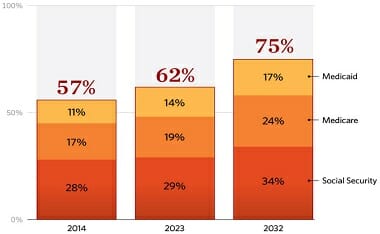In the above audio, Larry Elder reads from the below article via National Review entitled: “Poverty, Despair, and Big Government“
…For example, Maryland has one of the most generous welfare systems in the nation. A mother with two children participating in seven common welfare programs — Temporary Assistance for Needy Families (TANF), food stamps (SNAP), Medicaid, housing assistance, Supplemental Nutrition for Women, Infants, and Children (WIC), energy assistance (LIHEAP), and free commodities — could receive benefits worth more than $35,000. Yet, nearly a quarter of the people in Baltimore still live in poverty. In 1960, Baltimore’s poverty rate was just 10 percent. While some of the increase since then is a result of demographic and other structural changes, we’ve clearly been throwing a lot of money at poverty in the city without much result.
And while Baltimore’s high welfare benefits haven’t reduced poverty, they may well have exacerbated other social problems. For example, some studies have long shown that high welfare benefits correlate with high out-of-wedlock birth rates. It should not come as a surprise, then, that two-thirds of births in the city are to unmarried mothers, and almost 60 percent of Baltimore households are headed by single parents.
The unemployment rate in Baltimore in February was 8.4 percent, compared with just 5.5 percent nationally. In the Sandtown–Winchester/Harlem Park area, which is near the center of the unrest, more than half of the people did not have jobs, according to a February 2015 report from the Justice Policy Institute and the Prison Policy Initiative.
- RELATED: The Left’s Burning Cities
One reason for this is the city’s — and the state’s — unremitting hostility to business. The U.S. Chamber of Commerce reports that only seven states and the District of Columbia have a worse business climate than Maryland. The state’s tax burden is huge and growing. According to the Tax Foundation’s State Business Tax Climate Index, Maryland ranks a dismal 40th in terms of business taxes, and an even worse 45th in terms of personal-income taxes. According to this report, Maryland is one of just a few states where the personal-income tax creates “an unnecessary drag on economic activity.” The state’s small businesses face the nation’s seventh-highest marginal tax rates.
As if that were not bad enough, the city of Baltimore adds one of the highest property taxes among comparable cities. Despite a recent modest reduction in property-tax rates, Baltimore still has a tax rate more than twice the rate of most of the rest of the state. A recent study by the Minnesota Center for Fiscal Excellence and the Lincoln Institute of Land Policy ranked Baltimore twelfth out of 53 major cities in terms of high property taxes. When the city taxes are combined with state taxes, Baltimore ends up with the ninth worst tax burden out of 50 major American cities.
[….]
The city’s schools represent another failure of government. Teachers’ unions are among the most powerful special interests in Maryland. To cite just one example, even as other states were enacting right-to-work laws for public employees, Maryland passed a law mandating that all teachers pay fees to the Maryland State Education Association.
Although Baltimore ranks fourth among major cities in per-pupil expenditures for districts with more than 40,000 students and spends $16,578 a year per pupil — roughly 52 percent above the national average — more than a quarter of Baltimore students fail to graduate from high school. Fewer than half of Baltimore high-school students passed the last Maryland High School Assessment test. SAT scores for Baltimore students are more than 100 points below the national average.
Yet Maryland has one of the nation’s most restrictive charter-school laws. There are just 52 charter schools statewide. In neighboring Washington, D.C., 44 percent of the city’s public-school students are educated in the District’s 112 charter schools, according to the National Alliance for Public Charter Schools. Even within the public schools, choice is extremely limited in Maryland; parents are not generally allowed to send their children to schools outside their assigned district. Needless to say, any larger efforts to give parents more control over their children’s schooling — such as vouchers or tax credits — have gone nowhere.


